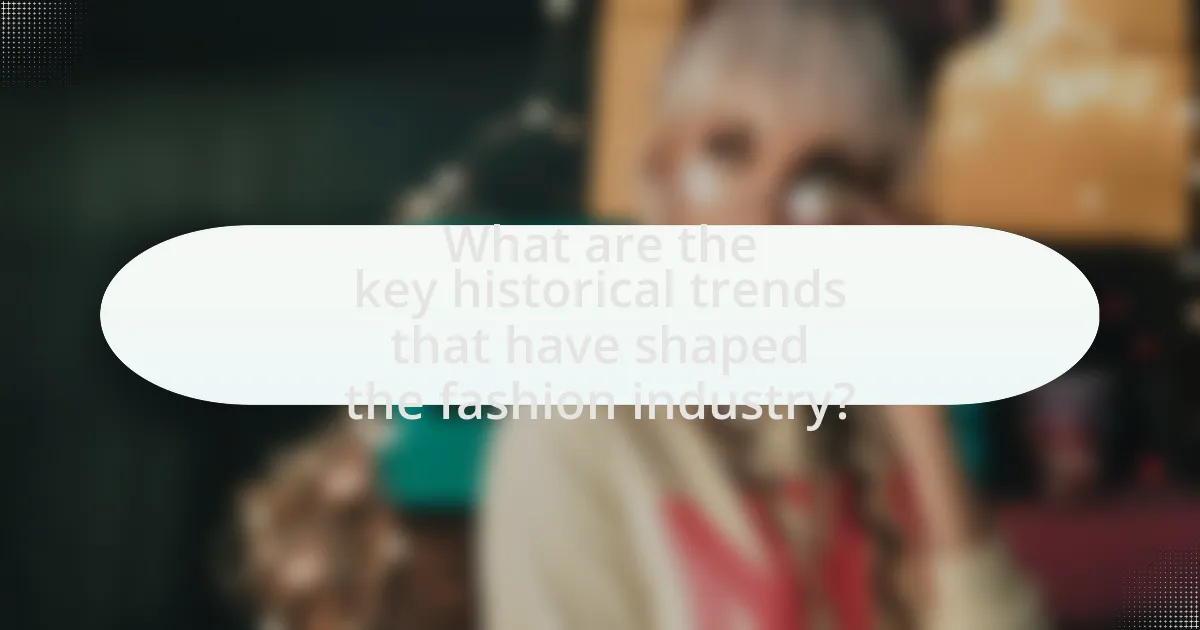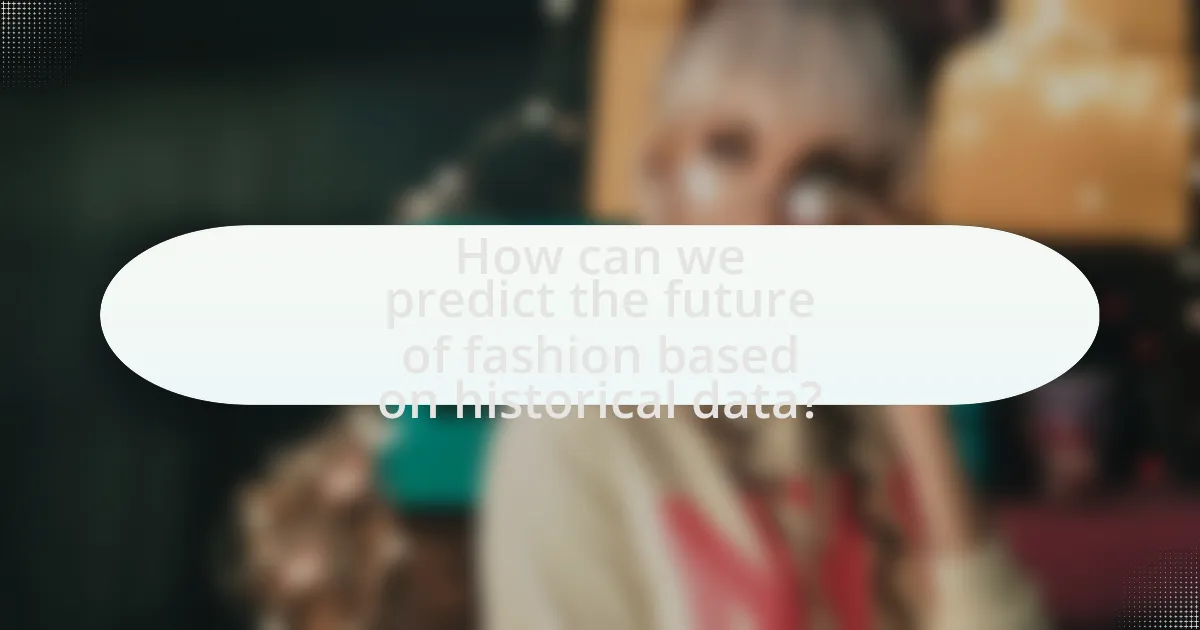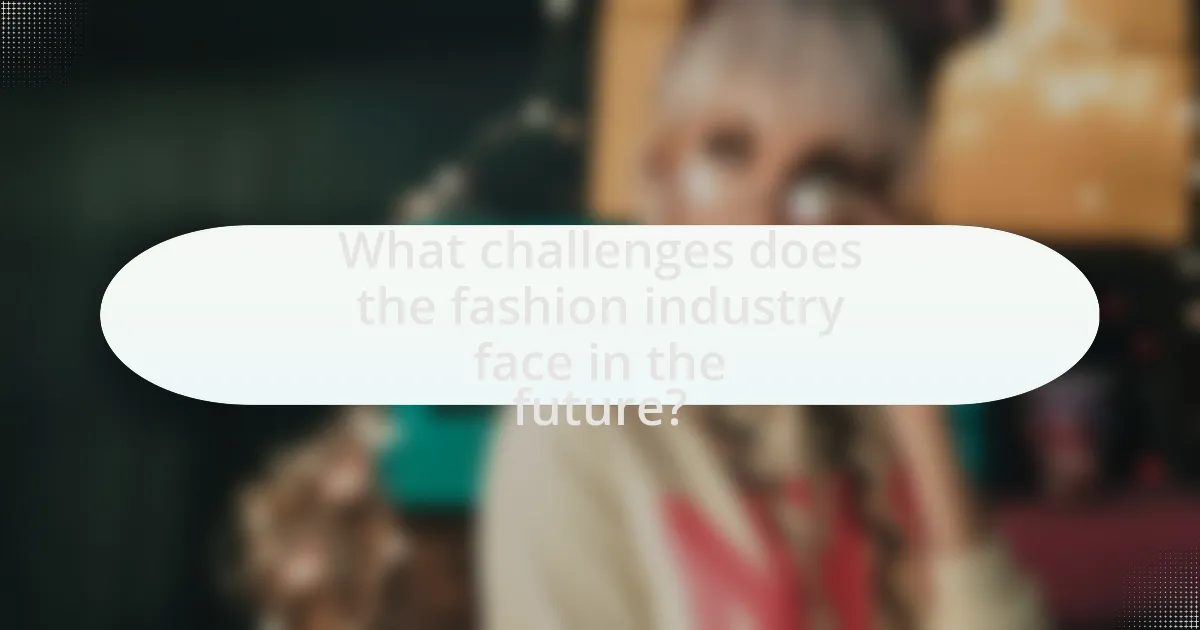The article “The Future of Fashion: Predictions Based on Historical Trends” examines the evolution of the fashion industry through key historical trends, including the Industrial Revolution, the rise of ready-to-wear fashion, and the impact of cultural movements. It highlights how past fashion movements influence contemporary styles and the role of cultural events in shaping trends. The article also discusses the effects of technological advancements on design and production, the cyclical nature of fashion cycles, and the significance of sustainability and personalization in future fashion choices. Additionally, it explores how economic factors and globalization impact fashion forecasting, providing insights into emerging trends and strategies for brands and consumers to navigate the industry’s future.

What are the key historical trends that have shaped the fashion industry?
Key historical trends that have shaped the fashion industry include the Industrial Revolution, which introduced mass production techniques, allowing for the widespread availability of clothing. The emergence of ready-to-wear fashion in the mid-20th century democratized style, making it accessible to a broader audience. Additionally, the influence of cultural movements, such as the 1960s counterculture and the rise of streetwear in the late 20th century, shifted fashion towards individual expression and casual styles. The globalization of fashion, driven by technology and communication advancements, has also played a crucial role in shaping trends, enabling cross-cultural influences and fast fashion’s rise. These trends collectively illustrate the evolution of fashion from exclusivity to inclusivity and the impact of societal changes on style.
How have past fashion movements influenced contemporary styles?
Past fashion movements have significantly influenced contemporary styles by reintroducing elements such as silhouettes, patterns, and materials that resonate with modern aesthetics. For instance, the 1970s bohemian style, characterized by flowing fabrics and ethnic prints, has seen a resurgence in today’s fashion, evident in the popularity of maxi dresses and wide-leg trousers. Additionally, the minimalist movement of the 1990s has shaped current trends favoring clean lines and neutral palettes, as seen in brands like COS and Everlane. Historical references, such as the punk movement’s DIY ethos, continue to inspire streetwear, emphasizing individuality and self-expression. These influences demonstrate how contemporary fashion often revisits and reinterprets past styles, creating a cyclical relationship between history and modern design.
What role did cultural events play in shaping fashion trends?
Cultural events significantly influence fashion trends by serving as platforms for expression and innovation. Historical examples include the impact of the 1960s counterculture movement, which introduced bold colors and patterns, reflecting societal shifts towards freedom and individuality. Similarly, fashion weeks and major cultural festivals showcase designers’ works, often setting trends that resonate globally. The rise of streetwear in the 1990s, influenced by hip-hop culture and urban art, illustrates how cultural phenomena can redefine mainstream fashion. These events not only inspire designers but also shape consumer preferences, creating a cyclical relationship between culture and fashion.
How did technological advancements impact fashion design and production?
Technological advancements significantly transformed fashion design and production by enhancing efficiency, creativity, and accessibility. Innovations such as computer-aided design (CAD) software allowed designers to create intricate patterns and visualize garments in 3D, streamlining the design process. Additionally, advancements in textile technology, including the development of smart fabrics, enabled the creation of garments with enhanced functionality, such as moisture-wicking and temperature regulation. Automation in manufacturing, exemplified by the use of sewing robots and 3D printing, reduced production time and costs, allowing for faster turnaround and more sustainable practices. According to a report by McKinsey & Company, the integration of technology in fashion has the potential to increase productivity by up to 30%. These advancements have not only reshaped the creative landscape but also made fashion more responsive to consumer demands and trends.
What are the major fashion cycles observed throughout history?
The major fashion cycles observed throughout history include the Victorian era (1837-1901), characterized by elaborate garments and corsetry; the Roaring Twenties (1920s), known for flapper dresses and a break from traditional styles; the Mid-Century Modern (1950s), which featured tailored silhouettes and the New Look by Dior; and the Grunge movement (1990s), marked by casual, anti-establishment attire. Each cycle reflects societal changes, such as the impact of World War I and II on fashion, the rise of youth culture, and shifts in gender roles, demonstrating how fashion evolves in response to cultural and historical contexts.
How do fashion cycles reflect societal changes?
Fashion cycles reflect societal changes by mirroring the cultural, economic, and political climates of their time. For instance, the rise of casual wear in the 1960s coincided with a shift towards individualism and counterculture movements, while the return of luxury fashion in the 1980s paralleled economic prosperity and consumerism. Historical events, such as the Great Depression, led to more practical and modest clothing styles, demonstrating how economic hardship influences fashion choices. Additionally, the increasing focus on sustainability in recent years reflects growing societal awareness of environmental issues, indicating that fashion is not only a reflection of aesthetic preferences but also a response to broader societal values and challenges.
What patterns can be identified in the rise and fall of fashion trends?
Fashion trends typically rise and fall in cycles influenced by cultural, social, and economic factors. Historical analysis shows that trends often emerge during periods of social change, such as the 1920s flapper movement reflecting women’s liberation, or the 1960s counterculture challenging traditional norms. Conversely, trends decline when they become oversaturated or when societal values shift, as seen with the decline of fast fashion in response to sustainability concerns. Additionally, the impact of technology, such as social media, accelerates the speed of trend cycles, allowing for rapid dissemination and eventual obsolescence. This cyclical nature is supported by studies indicating that fashion trends often follow a “90-year rule,” where styles re-emerge approximately every nine decades, demonstrating a pattern of revival and reinvention.

How can we predict the future of fashion based on historical data?
Predicting the future of fashion based on historical data involves analyzing past trends, consumer behavior, and socio-economic factors to identify patterns that may recur. Historical data reveals that fashion cycles often repeat approximately every 20 years, as seen in the resurgence of styles from the 1990s in the 2010s. Additionally, data from sources like the Fashion Institute of Technology indicates that economic downturns often lead to a rise in thrift and sustainable fashion, suggesting that current economic conditions can inform future trends. By leveraging analytics tools to assess sales data, social media trends, and cultural shifts, fashion brands can forecast upcoming styles and consumer preferences with greater accuracy.
What methodologies are used to analyze historical fashion trends?
Methodologies used to analyze historical fashion trends include quantitative analysis, qualitative analysis, and visual analysis. Quantitative analysis involves statistical methods to examine sales data, production numbers, and market trends over time, allowing researchers to identify patterns and shifts in consumer behavior. Qualitative analysis focuses on cultural and social contexts by examining fashion magazines, advertisements, and historical documents to understand the influences behind trends. Visual analysis entails studying images and artifacts from different time periods to interpret aesthetic changes and their significance. These methodologies collectively provide a comprehensive understanding of how historical fashion trends evolve and inform future predictions.
How do data analytics and consumer behavior studies inform predictions?
Data analytics and consumer behavior studies inform predictions by analyzing patterns in purchasing data and consumer preferences to forecast future trends. For instance, data analytics utilizes algorithms to process large datasets, revealing insights into buying habits, seasonal trends, and demographic shifts. A study by McKinsey & Company found that companies leveraging data analytics can improve their forecasting accuracy by up to 20%. Additionally, consumer behavior studies provide qualitative insights into motivations and preferences, allowing brands to tailor their offerings effectively. This combination of quantitative data and qualitative insights enables businesses to make informed predictions about future fashion trends, aligning their strategies with consumer demand.
What historical case studies provide insight into future trends?
Historical case studies such as the rise of fast fashion in the late 20th century and the impact of the 2008 financial crisis on consumer behavior provide significant insights into future trends in the fashion industry. The emergence of brands like Zara and H&M demonstrated how rapid production cycles and affordable pricing could reshape consumer expectations and shopping habits. Additionally, the 2008 financial crisis led to a shift towards sustainability and ethical consumption, as consumers became more conscious of their spending and the environmental impact of their purchases. These case studies illustrate how economic factors and consumer preferences can drive industry transformations, suggesting that future trends will likely continue to reflect a balance between affordability, sustainability, and ethical considerations.
What emerging trends are likely to shape the future of fashion?
Emerging trends likely to shape the future of fashion include sustainability, digital fashion, and personalization. Sustainability is becoming a priority as consumers increasingly demand eco-friendly materials and ethical production practices, with a report from McKinsey indicating that 67% of consumers consider sustainability when making a purchase. Digital fashion is gaining traction through virtual clothing and augmented reality experiences, driven by advancements in technology and the rise of the metaverse. Personalization is also on the rise, with brands leveraging data analytics to create tailored shopping experiences, as evidenced by a study from Deloitte showing that 36% of consumers express interest in personalized products. These trends reflect a shift towards a more conscious, tech-driven, and individualized approach in the fashion industry.
How is sustainability influencing future fashion choices?
Sustainability is significantly influencing future fashion choices by driving brands to adopt eco-friendly materials and ethical production practices. As consumers increasingly prioritize environmental responsibility, fashion companies are responding by integrating sustainable practices into their supply chains. For instance, a report by McKinsey & Company indicates that 67% of consumers consider sustainability when making a purchase, prompting brands to innovate with biodegradable fabrics and circular fashion models. This shift not only addresses consumer demand but also aligns with global sustainability goals, reinforcing the importance of responsible fashion in the industry’s future.
What technological innovations are expected to transform the fashion industry?
Technological innovations such as artificial intelligence, 3D printing, and blockchain are expected to transform the fashion industry. Artificial intelligence enhances design processes and personalizes shopping experiences by analyzing consumer data, leading to more targeted marketing strategies. 3D printing allows for rapid prototyping and on-demand production, reducing waste and enabling customization. Blockchain technology improves supply chain transparency and traceability, ensuring ethical sourcing and authenticity of materials. These innovations collectively address sustainability challenges and enhance consumer engagement, reshaping the future of fashion.

What challenges does the fashion industry face in the future?
The fashion industry faces significant challenges in sustainability, supply chain transparency, and adapting to digital transformation. Sustainability is critical as consumers increasingly demand eco-friendly practices; for instance, the Global Fashion Agenda reported that the industry is responsible for 10% of global carbon emissions. Supply chain transparency is essential due to rising scrutiny over labor practices and environmental impact, with 75% of consumers wanting to know the origins of their clothing. Additionally, digital transformation poses a challenge as brands must integrate technology to meet changing consumer behaviors, with e-commerce sales projected to reach $4.9 trillion by 2021, necessitating a shift in traditional retail strategies.
How do economic factors impact fashion forecasting?
Economic factors significantly impact fashion forecasting by influencing consumer spending habits, production costs, and market demand. For instance, during economic downturns, consumers tend to prioritize essential purchases over luxury items, leading to a decrease in demand for high-end fashion. This shift can be observed in the 2008 financial crisis, where luxury brands reported substantial declines in sales. Additionally, fluctuations in raw material prices, driven by economic conditions, affect production costs, which in turn influence pricing strategies and inventory management in the fashion industry. Therefore, understanding economic indicators such as GDP growth, unemployment rates, and consumer confidence is crucial for accurate fashion forecasting.
What role does globalization play in shaping future fashion trends?
Globalization significantly influences future fashion trends by facilitating the exchange of cultural aesthetics and production techniques across borders. This interconnectedness allows designers to draw inspiration from diverse cultures, leading to a fusion of styles that reflects a globalized society. For instance, the rise of streetwear, which blends elements from various cultural backgrounds, exemplifies how globalization shapes consumer preferences and trends. Additionally, global supply chains enable brands to source materials and labor from different countries, impacting pricing and accessibility. According to a report by McKinsey & Company, the global fashion industry is projected to grow by 3-4% annually, driven by these interconnected dynamics.
How can the fashion industry adapt to changing consumer preferences?
The fashion industry can adapt to changing consumer preferences by embracing sustainability and personalization. Research indicates that 66% of consumers are willing to pay more for sustainable brands, highlighting a significant shift towards eco-conscious purchasing decisions. Additionally, the rise of technology enables brands to offer personalized shopping experiences, such as AI-driven recommendations and custom designs, which cater to individual tastes. By integrating sustainable practices and leveraging technology for personalization, the fashion industry can effectively respond to evolving consumer demands.
What strategies can fashion brands employ to stay relevant?
Fashion brands can stay relevant by embracing sustainability, leveraging technology, and engaging with consumers through personalized experiences. Sustainability has become a critical factor, with 66% of global consumers willing to pay more for sustainable brands, indicating a shift towards eco-conscious purchasing. Technology, such as augmented reality and artificial intelligence, enhances customer engagement and streamlines operations, making brands more adaptable to market changes. Additionally, personalized marketing strategies, which utilize data analytics to tailor offerings to individual preferences, can significantly improve customer loyalty and brand relevance.
How can brands leverage historical insights for future success?
Brands can leverage historical insights for future success by analyzing past consumer behaviors and market trends to inform strategic decisions. For instance, examining historical sales data can reveal patterns in consumer preferences during specific seasons or economic conditions, allowing brands to tailor their product offerings and marketing strategies accordingly. A study by McKinsey & Company found that brands that utilize data-driven insights from past performance can increase their sales by up to 15%. By understanding what has resonated with consumers in the past, brands can anticipate future trends and adapt their strategies to meet evolving demands effectively.
What best practices should brands adopt to navigate future challenges?
Brands should adopt a proactive approach to sustainability and digital transformation to navigate future challenges. Emphasizing sustainable practices, such as using eco-friendly materials and reducing waste, aligns with consumer demand for environmentally responsible products, as evidenced by a 2021 McKinsey report indicating that 67% of consumers consider sustainability when making purchases. Additionally, investing in digital technologies, such as e-commerce platforms and data analytics, enables brands to enhance customer engagement and streamline operations, which is crucial in an increasingly online shopping environment. By integrating these best practices, brands can effectively respond to evolving market dynamics and consumer expectations.
What practical steps can consumers take to embrace the future of fashion?
Consumers can embrace the future of fashion by prioritizing sustainable and ethical brands. This shift is supported by a growing awareness of environmental issues, as the fashion industry is responsible for approximately 10% of global carbon emissions. By choosing brands that utilize eco-friendly materials and ethical labor practices, consumers can contribute to a more sustainable industry. Additionally, engaging in second-hand shopping and clothing swaps reduces waste and promotes a circular economy, which is increasingly recognized as a vital step in addressing fashion’s environmental impact.
How can consumers make informed choices based on historical trends?
Consumers can make informed choices based on historical trends by analyzing past data on fashion preferences, sales patterns, and consumer behavior. For instance, examining historical sales data reveals that certain styles, such as high-waisted jeans or oversized blazers, tend to resurface every few decades, indicating cyclical trends. Additionally, consumers can utilize resources like fashion reports and trend forecasting services, which compile historical data to predict future trends, helping them to anticipate what styles may become popular. By understanding these patterns, consumers can make purchasing decisions that align with both current and anticipated trends, ultimately leading to more satisfying and relevant fashion choices.
What resources are available for staying updated on fashion predictions?
To stay updated on fashion predictions, resources include fashion forecasting agencies, industry publications, and online platforms. Agencies like WGSN and Trendstop provide in-depth reports and analyses on upcoming trends, while publications such as Vogue Business and Business of Fashion offer insights and expert opinions on market shifts. Additionally, social media platforms like Instagram and Pinterest serve as real-time sources for emerging styles and consumer preferences, reflecting current trends and influencing future predictions.

Leave a Reply